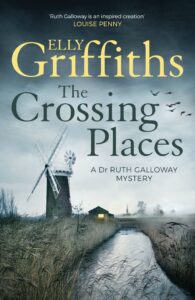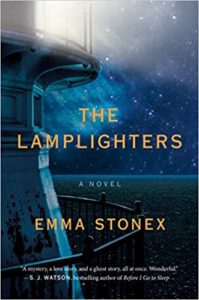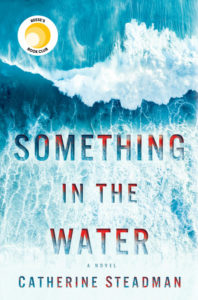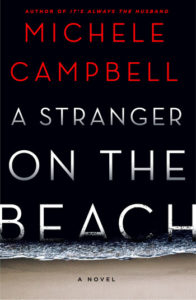If setting is a character, there is none more mysterious—and duplicitous—than an ocean beach, especially at night. The fearsome roaring of the waves, the pounding crash of breakers and the dreadful sucking sound of the undertow provide haunting backdrops to sinister intents. They remind the reader that much like those we love and assume love us in return, the ocean is never to be trusted. It can be serene one moment and violent the next.
In so many excellent novels of suspense, the ocean is a cold killer that lures its victims to murky depths, disposing of their remains quickly and permanently. It randomly crashes boats against cliffs, pulverizing passengers on a whim. It’s boobytrapped with undetectable currents that whisk the helpless to their deaths. It tempts. It bullies. It tricks. It mocks.
The ocean is without remorse. It cannot be charged, tried or punished for its crimes. It has killed before and will kill again. It is the perfect murderer.
I chose a dark Cape Cod beach as a setting for nineteen-year-old Kit Ellison’s disappearance in my novel of suspense, Do I Know You? because of its murky and misleading nature. Kit appears near death at the water’s edge when her younger sister, Jane, finds her after a frantic late-night search. After making a fateful decision to trust Kit’s welfare to a stranger, Jane’s sister is never seen again. When Kit’s T-shirt is found washed up on the marsh grasses days later, everyone, including the police, assumes she has met her fate at the bottom of the bay, the fierce currents ferrying away what the crabs haven’t consumed of evidence.
Do I Know You? is set in a fictional town on the Outer Cape which is famous for its wild, protected shoreline and arresting beauty. This part of the Cape reminds me of the remote shores featured in dozens of atmospheric suspense novels, from Baja California to Cornwall to the Hamptons to Tahiti. If ominous salt-water locales rock your boat, read on:

Untamed Shore by Silvia Moreno-Garcia
“The beach smelled of death.” So begins the much acclaimed Untamed Shore, the first crime novel by multi-talented Silvia Moreno-Garcia, the New York Times bestselling author of Mexican Gothic.
A master of creating baleful atmosphere, Moreno-Garcia shrouds the sunny 1979 Baja California setting in a cloud of gritty noir. Here the beach reeks of dead sharks, harvested for their livers. The ocean is “wild and contemplative” and poses danger when the young, naïve, and aspirational tourist guide Viridiana is taken under the wings of three Americans, who offer a chance to escape her depressed Mexican hometown. Viridiana is a compelling protagonist who must use her wits to dodge metaphorical sharks and deathly currents in an effort to survive in this compelling thriller.

The Guest List by Lucy Foley
The quintessential closed-room mystery usually involves an isolated structure in which a murder occurs and suspects must be, by logic, present in its confines. From Agatha Christie’s Murder on the Orient Express to Ruth Ware’s One by One and hundreds of mysteries between, before and since, unlucky and impulsive suspects have been trapped in trains, mountaintop castles, submarines, ski chalets and, in Foley’s excellent thriller, on the farthest rocky island off Ireland’s west coast.
Here, the frigid, endless Northern Atlantic is as merciless as the sharp rocks at the island’s base. It is an omnipresent character waiting to devour a hapless victim. Granted, there is no more romantic setting for a celebrity couple aiming to top all the posh trends by holding their wedding in the haunted folly overlooking the crashing waves.
But there are also treacherous peat bogs, hidden caves and dramatic cliffs. Add an incoming sea storm, harbored secrets, simmering plans of revenge, bruised egos, intoxicated guests stumbling along the jagged coastline at night hoping to settle scores and you’ve got a taut exciting, gripper of a novel.

The Blackhouse by Peter May
Speaking of remote islands and jagged cliffs, May’s The Blackhouse, the first in his “Lewis Trilogy,” has won accolades for May’s complex Edinburgh detective Fin Macleod, a native of the Isle of Lewis, the farthest tip of the northernmost island in the Outer Hebrides archipelago. To get off the island, like Macleod does, you need pluck and luck. Unfortunately, the latter is in short supply. Escape is almost impossible, especially when Macleod is dragged back to Lewis to investigate an eviscerated corpse hanging from a beam, a murder scene disturbingly reminiscent of one on his plate back in Edinburgh.
There are flashbacks to his difficult childhood, of course, including—especially—a traditional venture 40 miles across the Northern Atlantic to the uninhabited rocky outcropping of An Sgeir, the nesting place for the Northern Gannets whose chicks are called guga. The guga are considered a prime delicacy in the area and hunting them is a rite of passage for Lewis males who are permitted to take 2,000 each summer to kill, smoke and bring home as treasures.
The guga hunt in The Blackhouse is a nail-biting excursion. The paths along the An Sgeir’s cliffs are narrow and often slippery with sea spray and guga guano. An actual cliff hanger turns out to be a pivotal plot point that flips the novel on its head.

The Crossing Places by Elly Griffiths
Seaside coasts need not be ringed with jagged rocks to be ominous, as Elly Griffiths’s often humorous, always human, forensic archaeologist Ruth Galloway knows all too well in The Crossing Places, the first in her excellent Galloway series. Set on the other side of Great Britain on Norfolk’s flats, Galloway is called to investigate a collection of children’s bones discovered buried in a bleak beach. The sad reveal stirs up memories of another girl, abducted and never found.
Ruth lives near the site, alone, in a tiny house facing the salt marsh. The setting feels portentous. Apparently, its vast expanse of desolate grassland was once considered sacred among ancient settlers who viewed it as the division not only between the earth and the sea, but between life and death.
The book is saturated with the sights and smells of the marsh and the mystery of the mudflats that are as treacherous as they are occasionally fruitful with preserved Bronze Age artifacts—as well as more modern and horrifying discoveries.

The Lamplighters by Emma Stonex
The sea giveth and the sea taketh away, but, mostly, in Emma Stonex’s spectacular literary suspense novel, it taketh away. Men, children, joy, none is spared from the ocean’s capricious wrath as it torments the inhabitants of yet another rocky island. This time the setting is south of Cornwall, England, where a lighthouse—The Maiden—stands surrounded by the small cottages of the lamplighters’ families—women and children who daily slog through the monotony of confined living and the petty tensions of close quarters while keeping an eye on the fickle sea.
Based on the true story of missing lamplighters from a lighthouse in the Hebrides at the turn of the last century, Stonex has moved the men’s disappearance to the 1970s so women left behind can be interviewed twenty years later. What happened to the three men? Why were the clocks stopped, the tables set and the lighthouse locked? These questions drive the plot, but Stonex’s lyrical prose which summons the brininess of the sea and crashing waves, will linger long after the mystery is solved.

Something in the Water by Catherine Steadman
Not all water needs to be cold and murky to be dangerous. In Catherine Steadman’s glittering Something in the Water, trendy London newlyweds are taking a break from their decidedly First-World problems to honeymoon at an exclusive Bora Bora resort. It’s a dream getaway for the couple you love to hate, complete with a private bungalow that extends over the water, scuba-diving excursions, and lots of lacy designer lingerie.
The water is a clear, warm, turquoise blue, the palm trees are swaying, the staff is polite. What could go wrong in such a paradise? The question looms when, upon returning from a private scuba trip, Erin and Mark come across a sea of white papers and a satchel bobbing against their boat. It happens to be filled with the answer to their nagging issues.
There are several ethical choices the couple could make in this situation. Certainly, most readers would not advocate for theirs. But the sea has managed to hide the evidence, as it does, and so Erin and Mark feel comfortable, somewhat, in making a riskier move. And that’s what keeps the pages turning.

A Stranger on the Beach by Michelle Martinez Campbell
By law, all ocean beaches below the tideline in America must allow for public access, which sets the stage for an epic class conflict in A Stranger on the Beach. Wealthy Hamptons housewife Caroline Stark never would have met the “townie” Aiden Callahan with his captivating good looks and working-class background if she hadn’t found him standing outside her newly renovated beach home, staring up at it admiringly. Or is that possessively?
Their one-night stand sets off a series of bad decisions and frightening encounters, each retold by Caroline and then Aiden in their own very unreliable versions of events. The most terrifying scenes—a killer storm, near rape, murder—happen at the beach wealthy weekenders like Caroline have overtaken from average folks like Aiden. Does he act out of love for her or to reclaim the valuable beachfront parcel that once belonged to the Callahan clan?
***


















